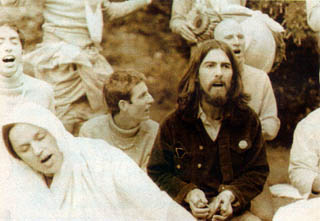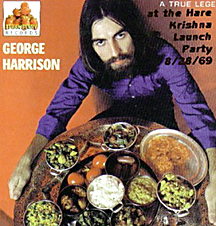
GEORGE HARRISON chanting with Krsna devotees

George Harrison
The word Veda has its Sanskrit root vid, which means "to know", or simply "knowledge". The word Veda also has three root meanings, representing its connection with the power of God, namely; 1) that Vedic knowledge is eternal; 2) Veda is the essential knowledge itself, which means that it provides knowledge of God, or that we can know the Supreme through the Veda; and 3) Veda gives the most desirable thing to the souls, which is the Divine Bliss that comes from our connection with God.
As most scholars on Vedic philosophy know, when you say Vedas you refer to the original four Vedas: the Rig, Yajur, Sama, and Atharva Vedas. From the four main Vedas are branches or appendices called Brahmanas, which relate to rituals and ceremonies. From these are derived the Aranyakas. The Upanishads are the appendices (the secret and esoteric knowledge) of the Aranyakas. When you say Veda (without the s) you not only refer to the four Vedas, but also to the Brahmanas, Aranyakas, and Upanishads, or all the texts that are considered Shruti. Shruti is considered the original revealed knowledge, which was unveiled to self-realized sages.
The remaining parts of Vedic literature consist of the Mahabharata and Bhagavad-gita, the Ramayana, and the Puranas. These are the Itihasas or histories and supplemental portions of the Vedic literature, which they call Smriti, or that which is remembered. When we say "Vedic literature", it refers to both Shruti and Smriti in a general way. However, some scholars think that the Shruti is the genuine Vedic portions of this philosophy and more important than the Smriti. So some may object to the use of the word "Vedic" to refer to that which includes all of the Vedic texts, both Shruti and Smriti. However, this is not an accurate view according to the Vedic texts themselves.
For example, the Brihadaranyaka Upanishad (4.5.11) also relates: "The Rig, Yajur, Sama, and Atharva Vedas, the Itihasas, Puranas, Upanishads, verses and mantras, sutras, and the spiritual knowledge and explanations within, all emanate from the Supreme Being." It not only says it once, but the Brihadaranyaka Upanishad says it again (2.4.10) as follows: "As from a fire kindled with wet fuel, clouds of smoke issue forth, so, my dear, verily, from this glorious great God has been breathed forth the Rig-veda, the Yajur-veda, the Sama-veda, Atharvanagirasa, Itihasas, Puranas, science of knowledge, mystic doctrines or Upanishads, pithy verses, aphorisms, elucidations and commentaries. From Him, indeed, are all these breathed forth."
Thus, they all have importance in presenting Vedic information, and one should not be biased toward one set of shastra or scripture to exclude the other. Therefore, to leave out the supplemental portions of the Vedic literature would deprive the reader of an enormous amount of Vedic knowledge and elaborated explanations. In this way, if anyone feels the "Vedic" tradition includes only the four Vedas up to the Upanishads, the Vedic tradition itself shows this as a wrong view, and that all of the ancient texts which support the Vedic conclusion are also Vedic and should be considered as such.

KRSNA as a child
70s invasion home -
https://www.angelfire.com/vt2/70sinvasion/